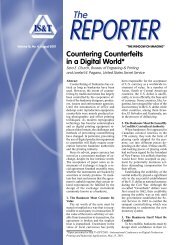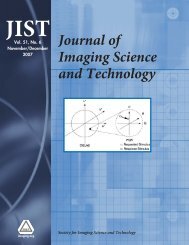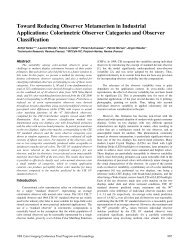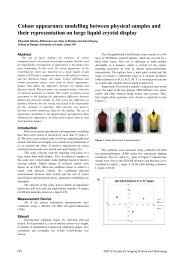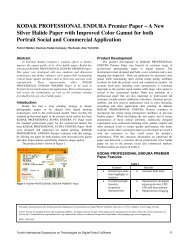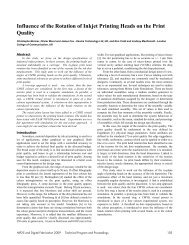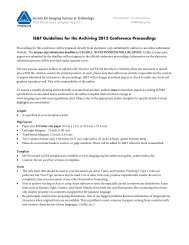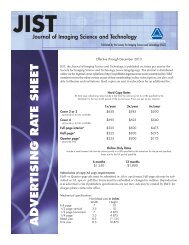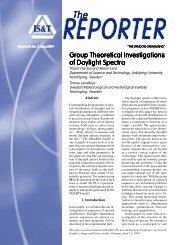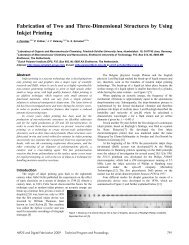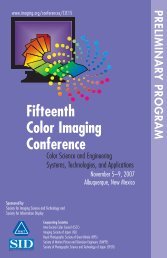Direct PSF estimation using a random noise target [7537-10]
Direct PSF estimation using a random noise target [7537-10]
Direct PSF estimation using a random noise target [7537-10]
You also want an ePaper? Increase the reach of your titles
YUMPU automatically turns print PDFs into web optimized ePapers that Google loves.
<strong>Direct</strong> <strong>PSF</strong> Estimation Using a Random Noise Target<br />
Johannes Brauers, Claude Seiler and Til Aach<br />
Institute of Imaging and Computer Vision, RWTH Aachen University<br />
Templergraben 55, 52056 Aachen, Germany<br />
ABSTRACT<br />
Conventional point spread function (<strong>PSF</strong>) measurement methods often use parametric models for the <strong>estimation</strong><br />
of the <strong>PSF</strong>. This limits the shape of the <strong>PSF</strong> to a specific form provided by the model. However, there are<br />
unconventional imaging systems like multispectral cameras with optical bandpass filters, which produce an, e.g.,<br />
unsymmetric <strong>PSF</strong>. To estimate such <strong>PSF</strong>s we have developed a new measurement method utilizing a <strong>random</strong> <strong>noise</strong><br />
test <strong>target</strong> with markers: After acquisition of this <strong>target</strong>, a synthetic prototype of the test <strong>target</strong> is geometrically<br />
transformed to match the acquired image with respect to its geometric alignment. This allows us to estimate the<br />
<strong>PSF</strong> by direct comparison between prototype and image. The <strong>noise</strong> <strong>target</strong> allows us to evaluate all frequencies<br />
due to the approximately “white” spectrum of the test <strong>target</strong> – we are not limited to a specifically shaped <strong>PSF</strong>.<br />
The registration of the prototype pattern gives us the opportunity to take the specific spectrum into account<br />
and not just a “white” spectrum, which might be a weak assumption in small image regions. Based on the <strong>PSF</strong><br />
measurement, we perform a deconvolution. We present comprehensive results for the <strong>PSF</strong> <strong>estimation</strong> <strong>using</strong> our<br />
multispectral camera and provide deconvolution results.<br />
Keywords: point spread function, deconvolution, <strong>noise</strong> <strong>target</strong>, registration, multispectral imaging<br />
1. INTRODUCTION<br />
Several methods for measuring the modulation transfer function (MTF), which is the frequency domain representation<br />
of the <strong>PSF</strong>, are available: 1 A complex and expensive method utilizing wavefront analysis with an<br />
interferometer <strong>using</strong> a laser source as a monochromatic light source computes the <strong>PSF</strong> by a Fourier transformation<br />
of the measured pupil wavefront. Other methods are based on the acquisition of a back-illuminated pinhole<br />
or knife-edge: Under the assumption of an infinitesimally small pinhole, the acquired image directly represents<br />
the <strong>PSF</strong> of the system. In practice, the pinhole is modeled as a disc and the differing input pattern has to be<br />
taken into account. Making the hole as small as possible reduces the available light and causes serious problems<br />
with the signal to <strong>noise</strong> ratio. An edge spread function may be derived by imaging a knife-edge. A derivation of<br />
the resulting image gives the one-dimensional line spread function in one particular direction. By rotating the<br />
knife-edge, a derivation of the two-dimensional <strong>PSF</strong> is possible. While the method <strong>using</strong> an interferometer is<br />
very expensive, the others require the acquisition of multiple images or are limited by the available light.<br />
In the ISO 12233 specification, 2 the MTF measurement with respect to the quality assessment of a camera<br />
and a lens is performed with a test chart showing sine waves with several frequencies and orientations. A<br />
measurement of the contrast of these patterns depending on the orientation and frequency allows a computation<br />
of the MTF. The measurement is extended to several image locations by Loebich et al. 3 However, both methods<br />
do not allow the computation of the <strong>PSF</strong> since they sample the MTF only at a few discrete orientations. While<br />
their intention is the measurement of an MTF with a fine frequency resolution, we are interested in the <strong>estimation</strong><br />
of the full two-dimensional <strong>PSF</strong>.<br />
Other approaches 4, 5 acquire a test chart with known spatial content and compute the <strong>PSF</strong> or MTF by<br />
comparing the acquired image with the test chart. The <strong>estimation</strong> is done either in the frequency domain (MTF)<br />
or in the spatial domain (<strong>PSF</strong>). Methods in the frequency domain perform a division of the frequency spectrum<br />
of the acquired image by the one of the template. Approaches in the spatial domain mostly utilize a <strong>PSF</strong> model<br />
function and fit its model parameters by minimizing an energy term: Mansouri et al. 6 use a disc shaped <strong>PSF</strong> to<br />
Further author information: (Send correspondence to Johannes Brauers.)<br />
Johannes Brauers: E–mail: Johannes.Brauers@lfb.rwth-aachen.de, Telephone: +49 (241) 80 27866<br />
Digital Photography VI, edited by Francisco Imai, Nitin Sampat, Feng Xiao, Proc. of SPIE-IS&T Electronic Imaging,<br />
SPIE Vol. <strong>7537</strong>, <strong>7537</strong>0B · © 20<strong>10</strong> SPIE-IS&T · CCC code: 0277-786X/<strong>10</strong>/$18 · doi: <strong>10</strong>.1117/12.837591<br />
SPIE-IS&T/ Vol. <strong>7537</strong> <strong>7537</strong>0B-1
estimate the blurring produced by the optical filters of a multispectral camera – the only parameter is the size<br />
of the disc. Wei et al. 7 utilize a Gaussian-shaped <strong>PSF</strong> with several parameters to characterize stray light and to<br />
reduce it finally. The model assumptions may be valid for some cases and allow a stable <strong>estimation</strong>, since only<br />
a few parameters have to be estimated.<br />
However, parameterized models for the <strong>PSF</strong> are not valid for, e.g., our multispectral camera 8, 9 shown in<br />
Fig. 1: Inside our camera, a filter wheel with optical bandpass filters is placed between the lens and the sensor.<br />
As we will show in section 2, the optical filters cause a position-dependent <strong>PSF</strong>, which cannot be parameterized<br />
with a simple model function. To a certain degree, this also holds for the system without optical filters and<br />
may apply for other camera systems, too. Our context for <strong>PSF</strong> <strong>estimation</strong> is the separate characterization of<br />
each passband of our multispectral camera: Since the optical bandpass filters differ in their optical properties<br />
like their refraction indices and thicknesses, the images acquired with some optical bandpass filters are slightly<br />
blurred. <strong>10</strong> Our aim is to measure the <strong>PSF</strong> and to recover the original sharpness.<br />
<br />
<br />
<br />
Figure 1. Our multispectral camera with its internal configuration sketched.<br />
To cope with the arbitrarily shaped <strong>PSF</strong>s, we use a non-parameterized <strong>PSF</strong> <strong>estimation</strong>, i.e., we estimate the<br />
optical transfer function (OTF) in the spectral domain and transform it to the spatial domain to obtain the<br />
<strong>PSF</strong>. The approach by Levy et al. 11 utilizes a test chart shown on a computer monitor, which is acquired by<br />
the tested camera and lens. However, the computed <strong>PSF</strong> is not space-resolved but applies for the whole image.<br />
The same holds for the work of Trimeche et al., 5 where a checkerboard pattern is used as a template for <strong>PSF</strong><br />
<strong>estimation</strong>. Joshi et al. 4 account for the spatial dependency of the <strong>PSF</strong> and utilize a test chart with a circular<br />
checkerboard pattern. However, as we will show in section 2, this pattern does not exhibit an (approximately)<br />
flat frequency spectrum and may have inferior performance with respect to <strong>PSF</strong> <strong>estimation</strong>.<br />
In the following section, we will describe the background and underlying principle of <strong>PSF</strong> <strong>estimation</strong>. In<br />
section 3, we present our algorithm for <strong>PSF</strong> <strong>estimation</strong> including the regularization of the <strong>PSF</strong>. We show results<br />
in the forth section before we conclude in the last section.<br />
2. PHYSICAL BACKGROUND<br />
To be independent of measurements of point spread functions (<strong>PSF</strong>) with a real lens and to have still an idea<br />
of the form of the <strong>PSF</strong>, we simulated an optical system which is similar to our real system: Fig. 2 shows the<br />
optical layout of a lens 12 which has the same focal length range and a similar optical layout compared to our lens<br />
(Nikon Nikkor AF-S DX 18-70mm). We included an optical bandpass filter, which is used in our multispectral<br />
camera to subdivide the visible electromagnetic spectrum. The filter has a refraction index n =2.05 and a<br />
thickness d = 5 mm. We focused the imaging system by optimizing the image distance and therefore minimized<br />
the size of the airy discs on the image surface.<br />
Fig. 3 shows the simulated point spread functions for various positions in the image plane, where each<br />
accumulation of points represents one <strong>PSF</strong>. It can be seen that mostly, the shape of the <strong>PSF</strong>s does not exhibit<br />
a radial symmetry and does not resemble a Gaussian shape. In addition, the <strong>PSF</strong>s depend on their spatial<br />
SPIE-IS&T/ Vol. <strong>7537</strong> <strong>7537</strong>0B-2
lens<br />
optical<br />
bandpass<br />
filter<br />
sensor<br />
plane<br />
Figure 2. Lens design 12 similar to the lens in our multispectral camera with additional optical bandpass filter. Three<br />
object rays are simulated.<br />
position. Therefore, it is crucial to account for a shift-variant <strong>PSF</strong> which is not restricted to a specific form. It<br />
can be modeled by<br />
i(x, y) = ∑ x 0,y 0<br />
h (x, y; x 0 ,y 0 ) · o (x 0 ,y 0 )+n(x, y) , (1)<br />
where the original image is denoted by o(x, y) and the blurred image by i(x, y). The spatially varying point<br />
spread function is given by h(x 0 ,y 0 ; x, y), yielding a specific <strong>PSF</strong> for each spatial image position x, y. Additional<br />
<strong>noise</strong> is modeled by n(x, y).<br />
1<br />
0.8<br />
0.6<br />
0.4<br />
0.2<br />
0<br />
20<br />
(a)<br />
(b)<br />
Figure 3. Blockwise <strong>PSF</strong> computation (a) performed by the optical simulation program ZEMAX <strong>using</strong> the lens from<br />
Fig. 2; each spot represents one <strong>PSF</strong>. The spatial dependency of the single <strong>PSF</strong>s can be clearly seen. The form of a<br />
specific <strong>PSF</strong> (b) does not exhibit a radial symmetry and does not resemble a simple Gaussian shape or disc shape.<br />
<strong>10</strong><br />
0<br />
0<br />
5<br />
<strong>10</strong><br />
15<br />
20<br />
25<br />
Since it is not feasible to take a separate <strong>PSF</strong> for each pixel into account and because neighboring point<br />
spread functions are considered to be similar, we split the image into blocks (96×80 pixel) and use one <strong>PSF</strong><br />
for each image block. Most of the following operations are therefore performed blockwise, i.e., the processing is<br />
described for one image block and applies for the others analogously. Eq. (1) therefore reduces to<br />
and<br />
i(x, y) =(p ∗ o)(x, y)+n(x, y) (2)<br />
I(u, v) =P (u, v)O(u, v)+N(u, v) (3)<br />
in the frequency domain. Here, the capital identifiers correspond to the lower case ones and P (u, v) is the optical<br />
SPIE-IS&T/ Vol. <strong>7537</strong> <strong>7537</strong>0B-3
transfer function (OTF) of the system. The OTF is then estimated in the frequency domain via<br />
I(u, v)<br />
ˆP (u, v) =<br />
Ô(u, v)<br />
(4)<br />
by the division of the acquired image by the estimated original image Ô(x, y) in the frequency domain. The<br />
<strong>estimation</strong> of Ô(x, y) is discussed in section 3.<br />
Several templates may be used to perform the <strong>PSF</strong> measurement. The checkerboard pattern in Fig. 4c<br />
is usually utilized in geometric camera calibration tasks. Trimeche et al. 5 use it as a template for the <strong>PSF</strong><br />
measurement. However, its frequency spectrum shown in Fig. 4d is inhomogeneous and exhibits frequency<br />
components near zero. These components appear in the denominator of Eq. (4) and prevent or at least complicate<br />
a reliable <strong>estimation</strong> of the OTF. Fig. 4a is an improved version of the checkerboard pattern presented by Joshi et<br />
al., 4 which exhibits all orientations of an edge but still has crossings which can be used for geometric calibration.<br />
However, the frequency domain still shows an inhomogeneous distribution.<br />
1<br />
--<br />
(a) (b) (c) (d)<br />
Figure 4. Templates for <strong>PSF</strong> <strong>estimation</strong> from Joshi et al. 4 and Trimeche et al. 5 are shown in (a) and (c), respectively.<br />
The subfigures (b) and (d) show the corresponding frequency domain representation (scaled logarithmically), which is<br />
inhomogeneous in both cases.<br />
We use the template shown in Fig. 5, which exhibits white uniform <strong>noise</strong> in the background and some<br />
registration markers and a gray wedge in the foreground. We acquire a part in the center of the test chart<br />
including the markers. Since white <strong>noise</strong> in the spatial domain transforms to white <strong>noise</strong> in the frequency<br />
domain as well, the frequency spectrum of our <strong>target</strong> is homogeneous and does not exhibit components near<br />
zero like the other charts shown in Fig. 4. The markers in the image are very small and do not tamper the<br />
homogeneity of the spectrum.<br />
The resolution of the test chart is a crucial aspect: If the resolution is too coarse, some frequency components<br />
are missing and the optical transfer function cannot be estimated in these frequency bands. If the resolution is<br />
too fine, the energy of the test chart is truncated by the lowpass of the optics. This causes a reduced contrast in<br />
the image and the signal to <strong>noise</strong> ratio (SNR) of the image is reduced, too. We have chosen a one-to-one relation<br />
between pixels on the template and the acquired image as a compromise. Since the lens and the bandpass filter<br />
represent to a certain degree a spatial lowpass filter, we expect the sampling theorem not to be violated.<br />
3. ESTIMATION ALGORITHM FOR THE <strong>PSF</strong><br />
Our algorithm for <strong>PSF</strong> <strong>estimation</strong> is illustrated in Fig. 6 and estimates the point spread function (<strong>PSF</strong>) from the<br />
acquired image and a digital template (see Fig. 5). First of all, the digital template is geometrically registered<br />
with the acquired image. Towards this end, the markers in the acquired image are detected and their positions are<br />
used to compute a preliminary geometric transformation between the acquired image and the digital template as<br />
indicated by dashed lines in Fig. 5. We have chosen a projective transformation 13 which allows a scaling, rotation<br />
and projective distortion between both images. To refine the transformation, we compute a subpixel-precise<br />
displacement vector field 9 between both images, starting from the transformation computed above. Combining<br />
both registration methods, we transform the digital template to match the acquired image geometrically. The<br />
SPIE-IS&T/ Vol. <strong>7537</strong> <strong>7537</strong>0B-4
egistration<br />
digital template<br />
acquired image<br />
Figure 5. Our <strong>noise</strong> <strong>target</strong> with localization markers and gray patches (left) is geometrically registered with the acquired<br />
image.<br />
acquired<br />
image<br />
digital<br />
template<br />
geometric<br />
registration<br />
tone curve<br />
adaptation<br />
FFT<br />
FFT<br />
OTF<br />
<strong>estimation</strong><br />
<strong>PSF</strong><br />
computation<br />
regularization<br />
<strong>noise</strong> reduction<br />
<strong>PSF</strong><br />
Figure 6. The proposed <strong>PSF</strong> <strong>estimation</strong> algorithm.<br />
remaining differences concern the intensity, <strong>noise</strong> and sharpness of the image: Since the acquired image has been<br />
acquired utilizing a real lens and a camera, it is not as sharp as the transformed digital template.<br />
In the next step tone curve adaptation, we compute a tone curve describing the relation between the intensity<br />
levels from the digital template and the acquired image. By doing so, we account for non-linear tone curves<br />
of the camera and the printer, although we did our best to get linear curves. To measure the combined tone<br />
curve, we utilize the gray wedge in the top left corner of our test chart, which has to be acquired separately.<br />
(The printer is assumed to exhibit a constant tone curve over the whole image.) We extract an averaged value<br />
of each gray patch and set the value into relation with the original value, which finally results in the combined<br />
tone curve. We then adapt the brightness levels of the digital template to the acquired image by applying the<br />
tone curve.<br />
After that, the images are split into small image blocks (96×80 pixel) and the fast Fourier transformation<br />
(FFT) is used to transform them to the frequency domain. The OTF can then be computed <strong>using</strong> Eq. (4) and<br />
the <strong>PSF</strong> is derived by an inverse FFT. Since our test chart consists of white <strong>noise</strong>, one might expect that it is<br />
necessary to assume a constant frequency spectrum instead of <strong>using</strong> a complex registration algorithm to estimate<br />
the frequency spectrum. However, since the <strong>estimation</strong> of the <strong>PSF</strong> is performed on small blocks with 7680 pixel<br />
values, this assumption is not given. In other words, the exact <strong>noise</strong> pattern in the examined region has to be<br />
known.<br />
Because the image is divided into image blocks, the number of pixels contributing to the <strong>estimation</strong> of the<br />
SPIE-IS&T/ Vol. <strong>7537</strong> <strong>7537</strong>0B-5
<strong>PSF</strong> #1 <strong>PSF</strong> #2 ...<br />
<strong>PSF</strong>, corresponds<br />
to one<br />
image block<br />
Figure 7. Basic principle for regularization of <strong>PSF</strong>s: the same pixels of each <strong>PSF</strong> are combined to a new block, to which<br />
the filter operations are applied to.<br />
<strong>PSF</strong> is reduced compared to an <strong>estimation</strong> taking all pixels of the image into account and thus the stability<br />
of the <strong>estimation</strong> is decreased. We therefore developed an algorithm which performs a regularization between<br />
neighboring <strong>PSF</strong>s. In the following, we assume that the optical system only changes slowly and neighboring<br />
<strong>PSF</strong>s are similar. The basic principle is shown in Fig. 7: The <strong>PSF</strong>s for different image blocks are arranged<br />
consecutively in a new image. The pixel at same position within each <strong>PSF</strong> are then rearranged to a new block.<br />
For example, the right block in the figure is composed of the top left pixel of each <strong>PSF</strong>. Each one of these blocks<br />
is then processed with filters and rearranged to its previous arrangement. The filtering includes a 3 × 3 median<br />
filter, which reduces stochastic errors between neighboring blocks: If the <strong>PSF</strong> <strong>estimation</strong> fails in one block and,<br />
e.g., produces abnormal pixel values, the <strong>PSF</strong> data is taken from neighboring <strong>PSF</strong>s. The following lowpass filter<br />
with the filter kernel<br />
⎛ ⎞<br />
1 2 1<br />
H = ⎝2 4 2⎠ (5)<br />
1 2 1<br />
ensures a certain smoothness between neighboring <strong>PSF</strong>s and reduces <strong>noise</strong>, too.<br />
1<br />
S(x,y)<br />
0.5<br />
25 0<br />
20 15<br />
5 <strong>10</strong> 15 20 25<br />
<strong>10</strong> 5<br />
Figure 8. Window for the reduction of <strong>PSF</strong> <strong>noise</strong>.<br />
The last operation is a thresholding operation, where the pixel values of the <strong>PSF</strong> below a certain locationdependent<br />
threshold are set to zero. This reduces the <strong>noise</strong> near the border of a <strong>PSF</strong>, where only small values<br />
are expected. The thresholding window (see Fig. 8) is defined by<br />
S(x, y) =1− T (x)T (y) (6)<br />
and the Tukey window 14 T (n) =<br />
{<br />
1 for 0 ≤|n| ≤α<br />
N<br />
[ ( )]<br />
0.5 1 + cos π n−α N 2<br />
2(1−α) N 2<br />
2<br />
for α N 2 ≤|n| ≤ N 2<br />
(7)<br />
where N is the size of the window. We chose the Tukey window since the width of the tip of the window can be<br />
SPIE-IS&T/ Vol. <strong>7537</strong> <strong>7537</strong>0B-6
adjusted by the parameter α. The thresholding operation is then performed by<br />
{<br />
0 for ˜p(x, y) < ˜pmax S(x, y)<br />
p(x, y) =<br />
˜p(x, y) otherwise<br />
(8)<br />
where ˜p max is the maximum value of the unfiltered <strong>PSF</strong> ˜p(x, y) for each block and p(x, y) the result of the<br />
operation. Finally, we normalize the <strong>PSF</strong> to make the sum of its coefficients equal to one.<br />
4. RESULTS<br />
We performed the <strong>PSF</strong> measurement <strong>using</strong> our seven-channel multispectral camera 8, 9 with a Nikon Nikkor AF-S<br />
DX 18-70mm lens. The internal grayscale camera is a Sony XCD-SX900 with a chip size of 6.4 mm×4.8 mm,<br />
a resolution of 1280×960 pixel and a pixel pitch of 4.65 μm × 4.65 μm. The lens has an F-mount known from<br />
single lens reflex (SLR) cameras, whereas the camera has a C-mount, which is often used for industrial cameras.<br />
The optical filters in our camera span a wavelength range from 400 nm to 700 nm with a bandwidth of 40 nm<br />
each and a wavelength distance of 50 nm.<br />
Fig. 9 shows the result of the tone curve measurement (see Fig. 6): A curve of the form y = ax b + c (solid<br />
line) has been fitted the measurement points (dots) with the parameters a =0.93, b =0.97, c = 28. The<br />
parameter b ≈ 1 indicates that there is almost a linear relation between the gray values of the template and the<br />
ones acquired from the printed test <strong>target</strong>. The high black level of c = 28 is noticeable; however, the camera<br />
itself exhibits a black level near the gray value <strong>10</strong>.<br />
Measured camera gray value<br />
250<br />
200<br />
150<br />
<strong>10</strong>0<br />
50<br />
measurements<br />
approximation<br />
0<br />
0 50 <strong>10</strong>0 150 200 250<br />
Gray value from digital template<br />
Figure 9. Tonecurve between original digital calibration <strong>target</strong> and its printed and acquired version.<br />
The results of the regularization in Fig. <strong>10</strong> show that the <strong>noise</strong> in the original <strong>PSF</strong> (Fig. <strong>10</strong>a) can be greatly<br />
reduced by averaging the <strong>PSF</strong> with neighboring <strong>PSF</strong>s (Fig. <strong>10</strong>b). The thresholding operation further reduces<br />
the <strong>noise</strong> – especially in border regions – and gives the final result shown in Fig. <strong>10</strong>c.<br />
a)<br />
b)<br />
c)<br />
Figure <strong>10</strong>. Regularization of the measured <strong>PSF</strong> (a) with mean/median filtering (b) and thresholding (c).<br />
SPIE-IS&T/ Vol. <strong>7537</strong> <strong>7537</strong>0B-7
Fig. 11 shows the blockwise <strong>PSF</strong> measurement for our multispectral camera when the 700 nm bandpass filter<br />
has been selected: Each box in the figure represents one <strong>PSF</strong> for the corresponding image block. The spatial<br />
dependency observed in the second section of this paper is indicated by a position-dependent shape of the <strong>PSF</strong>.<br />
A more detailed view of the marked <strong>PSF</strong> is presented in Fig. 12a: The <strong>PSF</strong> shown here does neither exhibit a<br />
radial symmetry, nor resemble a Gaussian shaped <strong>PSF</strong>. Therefore, a simple <strong>PSF</strong> model (e.g., Gaussian) is not<br />
suited to model the <strong>PSF</strong>. Fig. 12b shows the same region when the 550 nm bandpass filter is selected in our<br />
camera. Since we focused the camera’s lens <strong>using</strong> this passband, the <strong>PSF</strong> is much smaller – which corresponds<br />
to a sharper image.<br />
. ......... ..II A<br />
I<br />
Ill...... .4',<br />
I<br />
1<br />
a<br />
I<br />
I 1<br />
11 1<br />
I I I I I I I I I I I I<br />
I I I I I I I I I 3 1 I I $<br />
I I I I I I I I I I 3 1 1 1 1<br />
Figure 11. Blockwise <strong>PSF</strong> <strong>estimation</strong> for the 700 nm passband; each box shows the <strong>PSF</strong> of its corresponding image block.<br />
A 3D plot for the marked region is given in Fig. 12.<br />
a<br />
0.07<br />
0.5<br />
0.06<br />
0.05<br />
0.04<br />
0.4<br />
0.3<br />
0.03<br />
0.02<br />
0.01<br />
0.2<br />
0.1<br />
0<br />
20<br />
0<br />
<strong>10</strong><br />
0<br />
5<br />
<strong>10</strong><br />
15<br />
20<br />
25<br />
20<br />
<strong>10</strong><br />
0<br />
0 0<br />
5<br />
<strong>10</strong><br />
(a) 700 nm passband<br />
(b) 550 nm passband<br />
Figure 12. Detailed <strong>PSF</strong>s for the marked block in Fig. 11 for two passbands.<br />
15<br />
20<br />
25<br />
To validate the <strong>PSF</strong> <strong>estimation</strong>, we also performed a deconvolution <strong>using</strong> the above estimated <strong>PSF</strong>. We used<br />
the <strong>random</strong> test <strong>target</strong> with markers to produce the image in Fig. 13: The left area shows a crop of the acquired<br />
image, which is quite blurry. The lower right crop presents the synthetic prototype, which has been registered<br />
to match the acquired image geometrically. It is used to estimate the <strong>PSF</strong> – together with the acquired image.<br />
The upper crop shows the deconvolution result, where the sharpness of the original image has approximately<br />
been restored. For deconvolution, we used the algorithm from Levin et al. 15<br />
SPIE-IS&T/ Vol. <strong>7537</strong> <strong>7537</strong>0B-8
Deconvolution<br />
Acquisition<br />
deconvolve<br />
estimate <strong>PSF</strong><br />
Synthetic prototype<br />
Figure 13. Our <strong>random</strong> <strong>noise</strong> calibration <strong>target</strong> in three different versions: The <strong>PSF</strong>s are estimated utilizing the synthetic<br />
prototype and the acquired image and are used to deconvolve the acquired image.<br />
5. CONCLUSIONS<br />
By performing a simulation of an optical system, we have shown an example for a spatially varying <strong>PSF</strong> which has<br />
a shape of considerable complexity and cannot be characterized with a simple model function. We discussed the<br />
frequency spectrum properties of some test charts for <strong>PSF</strong> <strong>estimation</strong> and presented our own <strong>target</strong> with white<br />
<strong>noise</strong> and some additional markers. Based on this chart, we described our <strong>PSF</strong> <strong>estimation</strong> algorithm including<br />
a registration and linearization of the template with respect to the acquired image. The proposed regularization<br />
technique reduces <strong>noise</strong> and ensures a smooth transition between neighboring <strong>PSF</strong>s. Our <strong>PSF</strong> measurements<br />
confirm the assumption of an asymmetric and spatially varying <strong>PSF</strong>. A deconvolution with the measured <strong>PSF</strong><br />
shows that the sharpness of the image can be clearly enhanced.<br />
ACKNOWLEDGMENTS<br />
The authors acknowledge gratefully funding by the German Research Foundation (DFG, grant AA5/2-1).<br />
REFERENCES<br />
[1] Wilcox, M., “How to measure MTF and other properties of lenses,” tech. rep., Optikos Corporation, 286<br />
Cardinal Medeiros Ave Cambridge, MA 024141 USA (July 1999).<br />
[2] “Electronic still-picture cameras resolution measurements.” ISO12233:2000(E) (2000).<br />
[3] Loebich, C., Wueller, D., Klingen, B., and Jaeger, A., “Digital camera resolution measurement <strong>using</strong> sinusoidal<br />
siemens stars,” in [IS&T/SPIE Electronic Imaging], 65020N–1–65020N–11 (Jan 2007).<br />
[4] Joshi, N., Szeliski, R., and Kriegman, D. J., “<strong>PSF</strong> <strong>estimation</strong> <strong>using</strong> sharp edge prediction,” in [IEEE<br />
Conference on Computer Vision and Pattern Recognition, CVPR], 1–8 (23-28 June 2008).<br />
[5] Trimeche, M., Paliy, D., Vehvilainen, M., and Katkovnic, V., “Multichannel image deblurring of raw color<br />
components,” in [IS&T/SPIE Electronic Imaging], Bouman, C. A. and Miller, E. L., eds., 5674, 169–178,<br />
SPIE (March 2005).<br />
[6] Mansouri, A., Marzani, F. S., Hardeberg, J. Y., and Gouton, P., “Optical calibration of a multispectral<br />
imaging system based on interference filters,” SPIE Optical Engineering 44, 027004.1–027004.12 (Feb 2005).<br />
[7] Wei, J., Bitlis, B., Bernstein, A., de Silva, A., Jansson, P. A., and Allebach, J. P., “Stray light and shading<br />
reduction in digital photography - a new model and algorithm,” in [IS&T/SPIE Electronic Imaging], (Jan<br />
2008).<br />
SPIE-IS&T/ Vol. <strong>7537</strong> <strong>7537</strong>0B-9
[8] Brauers, J., Schulte, N., Bell, A. A., and Aach, T., “Multispectral high dynamic range imaging,” in<br />
[IS&T/SPIE Electronic Imaging], 6807 (Jan 2008).<br />
[9] Brauers, J., Schulte, N., and Aach, T., “Multispectral filter-wheel cameras: Geometric distortion model and<br />
compensation algorithms,” IEEE Transactions on Image Processing 17, 2368–2380 (Dec 2008).<br />
[<strong>10</strong>] Brauers, J. and Aach, T., “Longitudinal aberrations caused by optical filters and their compensation in<br />
multispectral imaging,” in [IEEE International Conference on Image Processing (ICIP2008)], 525–528 (CD–<br />
ROM), IEEE, San Diego, CA, USA (Oct 2008).<br />
[11] Levy, E., Peles, D., Opher-Lipson, M., and Lipson, S. G., “Modulation transfer function of a lens measured<br />
with a <strong>random</strong> <strong>target</strong> method,” Applied Optics 38, 679–683 (Feb 1999).<br />
[12] Hayakawa, S., “Zoom lens system.” Patent (Mar 2005). US. Pat. 2005/0068636 Al.<br />
[13] Hartley, R. I. and Zisserman, A., [Multiple View Geometry in Computer Vision], Cambridge University<br />
Press, ISBN: 0521540518, second ed. (2004).<br />
[14] Harris, F., “On the use of windows for harmonic analysis with the discrete fourier transform,” Proceedings<br />
of the IEEE 66(1), 51–83 (1978).<br />
[15] Levin, A., Fergus, R., Durand, F., and Freeman, W. T., “Deconvolution <strong>using</strong> natural image priors,” (2007).<br />
http://groups.csail.mit.edu/graphics/CodedAperture/SparseDeconv-LevinEtAl07.pdf.<br />
SPIE-IS&T/ Vol. <strong>7537</strong> <strong>7537</strong>0B-<strong>10</strong>


![Direct PSF estimation using a random noise target [7537-10]](https://img.yumpu.com/22620054/1/500x640/direct-psf-estimation-using-a-random-noise-target-7537-10.jpg)

